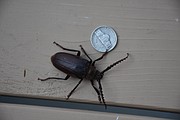The beetle with long horns!
Don Bartling Contributing Writer | Hagadone News Network | UPDATED 6 years, 4 months AGO
Last week while barbecuing on my deck I was suddenly alarmed by an uninvited guest that flew in and landed on my deck floor beside the table next to the grill. The big bug started screeching an alarming sound. The disturbing guest was a robust, reddish brown, almost black colored bug. He appeared to be a giant beetle with unusually long antennas.
Having been intrigued by his size, appearance and noise-making ability I decided to get my camera and take a few pictures. Upon close inspection I noticed the bug had three sharp spines on each side of the thorax and saw-toothed antennae. Upon researching the male giant root borer beetle, or California prionus, I found the most impressive characteristics were an antennae with 12 segments — more than two-thirds the length of their body. The female has a more slender antennae, about half of their body length. The adults are active in the summer through early fall, they fly at dusk or in the evening.
The beetle makes its sound by rocking his head up and down, it rubs ridges against the inside margin of the thorax to create the squeaking sound — a form of sound production among many insects called “stridulation.” It is usually only the male that calls and each species has its own distinctive song.
The giant root borer beetle is widely distributed in western North America from Baja California and Mexico to Alaska. The majority of the three- to five-year life cycle is spent underground as larvae, feeding on the roots of trees and shrubs. The larvae are often referred to as round-headed borers because of their cylindrical body shape.
The adults are commonly known as long-horned beetles because of the extended length of their antennae. Infestations can cause direct or indirect death of fruit trees due to girdling of the root cambium and introduction of secondary pathogens that lead to decay. Once an orchard is infested, it is difficult to prevent increase and spread of the beetle to nearby trees.
Larvae are cream to brown in color and grow from less than ¼ inch to 3 inches in length over a three- to five-year period. Body segmentation is strongly evident and the head is dark brown with large chewing mandibles.
The larva feed primarily on living deciduous trees and also on roots of vines, grasses and decomposing hardwoods and conifers. They will also attack fruit trees growing on light, well-drained soils such as apple, cherry and peach.
The adult is attracted to light at night and sounds like a small airplane approaching. The larvae develop in dead and decaying logs, stumps and roots, and the adults emerge during the summer months. Almost any dead wood will serve as a breeding site. Both larvae and adults are relatively harmless. The adult might pinch you with its mouthparts if you pick it up wrong. The adults are vulnerable to animals eating them, including skunks, owls, cats and some bats.
Discover Boundary County. Enjoy the outdoors!
ARTICLES BY DON BARTLING CONTRIBUTING WRITER

About the Douglas fir
“The big tree is nature’s forest masterpiece, and so far as I know, the greatest of living things.” — John Muir 1838-1914 “Father of the National Parks” and author.

Winter on the hoof: How deer, elk and moose cope with the snow!
“When snow falls, nature listens.”




